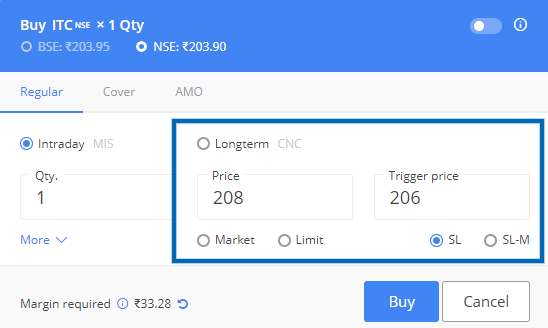What is the trigger price in a stoploss order?
The trigger price is the point at which a buy or sell order becomes active for execution on the exchange servers. When the stock's price reaches the trigger price set, the order is sent to the exchange servers.
Once the stop-loss order is triggered, the limit price becomes the price at which shares will be sold or bought. To learn more about limit orders, see
What are limit and market orders?
The stop-loss (SL) order consists of two price components:
- The stop-loss price is also referred to as the stop-loss limit price.
- The stop-loss trigger price is referred to as the trigger price.
Example Scenario
- A client places an SL (Stop Loss - Limit) for ITC.
- Once the stock price reaches ₹206, the order becomes active, triggering a limit order at ₹208 sent to the exchange.
- The stock will be purchased at either ₹208 or a lower price if sellers are available at that point.

A Stoploss order is a passive order. The trigger price acts as a threshold, and the stoploss order becomes active only when the market price crosses this threshold, whether it's above or below the stoploss price. To learn more about stoploss orders, see
What are stop loss orders and how to use them?
Did you know? A stoploss order is only valid for a trading day. If a stop loss order is not triggered during that day, it will automatically expire at the end of the trading session. To have an order that remains active across multiple trading sessions (up to 1 year) until the trigger condition is met, a GTT order can be placed. To learn more about GTT, see How to use the Good Till Triggered (GTT) feature?
Still need help?


